


|

|
The deeply recessed south porch |
| This page shows details of the tympanum, the arched area directly above the portal. Also illustrated with details on this site are the trumeau (the vertical supporting post between the leaves of a doorway), the jambs--on each side of the doorway, and the side walls, which are decorated with narrative sculpture. | 
| |
The tympanum with the apocalyptic vision of the Second ComingSee Revelations, Chapter 4. | ||
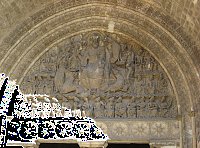
|
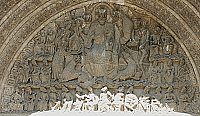
|
Here are depicted Christ in Glory with seraphim and the symbols of the Evangelists. Below and beside him in rows are the twenty-four elders, crowned, holding chalices and musical instruments, praising him with song. The clouds of Heaven or the rippling "sea of glass" (Revelations 4: 6) provides a boundary line. |
Because the tympanum is both filled with figures and now dirty, it's difficult to make out the design. It has thirty-one figures: the representation of Christ, which occupies three registers, a size which befits his importance, the 24 Elders beneath and flanking him, and two angels and the four symbols of the Evangelists which also flank him . On the left side (Christ's right) are a seraph holding a phylactery, who standing is the height of the seated Christ--again height related to a hieratic scale; the symbol for Matthew, a beautiful elongated crossed-legged angel; and the lion, symbol for Mark. On the opposite side there are a tall seraph who holds a scroll (the record of deeds on earth); the eagle, symbol of John; and the winged ox, symbol for Luke.Left: detail of left side; center: detail of center; right: detail of right side | ||
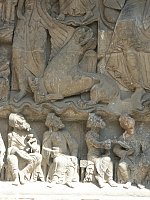
|
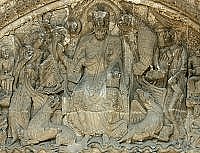
|

|
The outer edge of the tympanum and the archivoltsThe archivolts have foliate designs, the curve of which is echoed by the flat folded ribbon which circles the outer edge of the tympanum but which is mostly concealed at the top by the wings of the figures. | ||
| Christ is the calm center with all eyes and movement directed toward him. Many of the figures have distorted anatomy or radical torsion, partly because they turn toward Christ and partly for the linear design. | 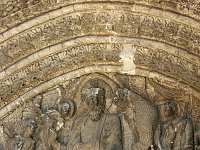
|
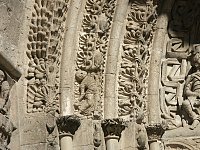
|
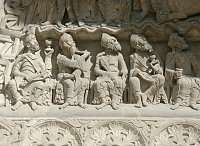
|
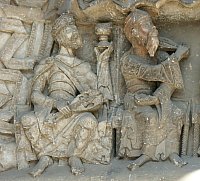
|
The Elders on the bottom rowLinear design is important to the sculptor, perhaps more than plastic qualities. At the same time, the artist conveys some sense of realism. Note, for example, the convincing hand of Christ holding the book. Here the Elders have a sense of animation and motion and bare feet and swelling calves are depicted realistically. |
Variety within samenessAlthough the twenty-four have the same functions, beards, hair, and garments are different. Although the Elders are all seated and all turned approximately toward Christ, there is variety within this formula. Some even have crossed legs, their heads are cocked in various ways, crowns are different in design, drapery folds fall in interesting patterns of zigzags and arcs, and they hold their instruments and chalices in varied ways. |
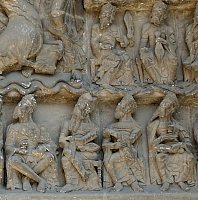
| |

|
The lintelThe lintel has ten concave rosettes (like dishes) inside a rope design issuing from the mouth of a grotesque animal, partly visible here on the far left. |
|
Works Consulted or Quoted:
M. F. Hearn. Romanesque Sculpture: The Revival of Monumental Stone Sculpture in the Eleventh and Twelfth Centuries. Ithaca, NY: Cornell UP, 1981.
Meyer Schapiro. The Sculpture of Moissac. NY: Braziller, 1985.
M. Alison Stones. Extensive medieval website.
 Go to Moissac Index.
Go to Moissac Index.
 Click here to return to index of art historical sites.
Click here to return to index of art historical sites.
 Click here to return to index of artists and architects.
Click here to return to index of artists and architects.
 Click here to return to chronological index.
Click here to return to chronological index.
 Click here to see the home page of Bluffton University.
Click here to see the home page of Bluffton University.

